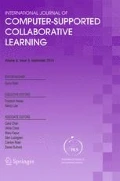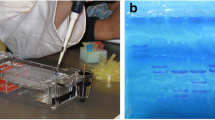Abstract
This paper reports on a study of teacher support in experimental computer-supported collaborative learning (CSCL) settings where students engage with graphs in real-time labs within the context of school science. Real-time labs are digital devices and software connected to student-controlled sensors or probes that can measure and visualize data graphically. The empirical setting was a science project about ocean acidification (OA) where lower secondary school students conducted measurements of the pH value of water with increased concentrations of CO2. The analytical focus is on student–teacher interaction during group-work activities where the students carried out, reviewed and reported on the real-time lab experiment. The analyses show that students needed additional support from the teacher in interpreting the real-time graphs and in making connections between the graphic representation, the practical undertakings of the experiment and the underlying scientific phenomena. Most importantly, the study demonstrates the complexity of teacher support in CSCL settings and how this type of support intersects with the support provided by digital resources, peer collaboration and applied instructional design.





Similar content being viewed by others
References
Adams, D. D., & Shrum, J. W. (1990). The effects of microcomputer-based laboratory exercises on the acquisition of line graph construction and interpretation skills by high school biology students. Journal of Research in Science Teaching, 27(8), 777–787.
Ainsworth, S. (2006). DeFT: A conceptual framework for considering learning with multiple representations. Learning and Instruction, 16(3), 183–198.
Ares, N., Stroup, W. M., & Schademan, A. R. (2009). The power of mediating artifacts in group-level development of mathematical discourses. Cognition and Instruction, 27(1), 1–24.
Arnseth, H. C., & Krange, I. (2016). What happens when you push the button? Analyzing the functional dynamics of concept development in computer supported science inquiry. International Journal of Computer-Supported Collaborative Learning, 11(4), 479–502.
Bezemer, J., & Kress, G. (2008). Writing in multimodal texts - A social semiotic account of designs for learning. Written Communication, 25(2), 166–195.
Derry, S. J., Pea, R. D., Barron, B., Engle, R. A., Erickson, F., Goldman, R., et al. (2010). Conducting video research in the learning sciences: Guidance on selection, analysis, technology, and ethics. Journal of the Learning Sciences, 19(1), 3–53.
Dillenbourg, P. (2013). Design for classroom orchestration. Computers & Education, 69, 485–492.
Erkens, M., Bodemer, D., & Hoppe, H. U. (2016). Improving collaborative learning in the classroom: Text mining based grouping and representing. International Journal of Computer-Supported Collaborative Learning, 11(4), 387–415.
Friedler, Y., & McFarlane, A. E. (1997). Data logging with portable computers, a study of the impact on graphing skills in secondary pupils. Journal of Computers in Mathematics and Science Teaching, 16(4), 527–550.
Furberg, A. (2016). Teacher support in computer-supported lab work: Bridging the gap between lab experiments and students’ conceptual understanding. International Journal of Computer-Supported Collaborative Learning, 11(1), 89–113.
Furberg, A., Kluge, A., & Ludvigsen, S. (2013). Student sensemaking with science diagrams in a computer-based setting. International Journal of Computer-Supported Collaborative Learning, 8(1), 41–64.
Gillen, J., Littleton, K., Twiner, A., Staarman, J. K., & Mercer, N. (2008). Using the interactive whiteboard to resource continuity and support multimodal teaching in a primary science classroom. Journal of Computer Assisted Learning, 24(4), 348–358.
Glazer, N. (2011). Challenges with graph interpretation: A review of the literature. Studies in Science Education, 47(2), 183–210.
Greiffenhagen, C. (2012). Making rounds: The routine work of teacher during collaborative learning with computers. International Journal of Computer-Supported Collaborative Learning, 7(1), 11–42.
Ivarsson, J., Linderoth, J., & Säljö, R. (2009). Representations in practices: A socio-cultural approach to multimodality in reasoning. In J. Carey (Ed.), The Routledge handbook of multimodal analysis (pp. 201–212). London: Routledge.
Järvelä, S., Kirschner, P. A., Hadwin, A., Järvenoja, H., Malmberg, J., Miller, M., & Laru, J. (2016). Socially shared regulation of learning in CSCL: Understanding and prompting individual- and group-level shared regulatory activities. International Journal of Computer-Supported Collaborative Learning, 11(3), 263–280.
Jefferson, G. (1984). Transcription notation. In J. Atkinson & J. Heritage (Eds.), Structures of social interaction (pp. ix–xvi). New York: Cambridge University Press.
Jordan, B., & Henderson, A. (1995). Interaction analysis: Foundations and practice. The Journal of the Learning Sciences, 4(1), 39–103.
Jornet, A., & Roth, W. M. (2015). The joint work of connecting multiple (re)presentations in science classrooms. Science Education, 99(2), 378–403.
Kelly, G. J., & Crawford, T. (1997). An ethnographic investigation of the discourse processes of school science. Science Education, 81(5), 533–559.
Knain, E. (2015). Scientific literacy for participation - A systemic functional approach to analysis of school science discourses. Rotterdam: Sense Publishers.
Leinhardt, G., Zaslavsky, O., & Stein, M. K. (1990). Functions, graphs, and graphing: Tasks, learning, and teaching. Review of Educational Research, 60(1), 1–64.
Lemke, J. L. (1998). Multiplying meaning: Visual and verbal semiotics in scientific text. In J. R. Martin & R. Veel (Eds.), Reading science (pp. 87–113). London: Routledge.
Lindwall, O., & Ivarsson, J. (2011). Difference that make a difference: Contrasting the local enactment of two technologies in a kinematics lab. In S. Ludvigsen, A. Lund, I. Rasmussen, & R. Säljö (Eds.), Learning across sites: New tools, infrastructures and practices (pp. 364–380). London: Routledge.
Lindwall, O., & Lymer, G. (2008). The dark matter of lab work: Illuminating the negotiation of disciplined perception in mechanics. Journal of the Learning Sciences, 17, 180–224.
Linell, P. (1998). Approaching dialogue: Talk, interaction and contexts in dialogical perspective. Amsterdam: John Benjamins.
Linell, P. (2009). Rethinking language, mind and world dialogically: Interactional and contextual theories of human sense-making. Charlotte: Information Age Publishing.
Linn, M. C., & Eylon, B.-S. (2011). Science Learning and instruction: Taking advantage of technology to promote knowledge integration. New York: Routledge.
Linn, M. C., Layman, J. W., & Nachmias, R. (1987). Cognitive consequences of microcomputer-based laboratories: Graphing skills development. Contemporary Educational Psychology, 12(3), 244–253.
Ludvigsen, S. (2016). CSCL towards the future: The second decade of ijCSCL. International Journal of Computer-Supported Collaborative Learning, 11(1), 1–7.
Ludvigsen, S., & Arnseth, H. C. (2017). Computer-supported collaborative learning. In E. Duval, M. Sharples, & R. Sutherland (Eds.), Technology enhanced learning (pp. 47–58). Chicago: Springer International Publishing.
Mäkitalo-Siegl, K., Kohnle, C., & Fischer, F. (2011). Computer-supported collaborative inquiry learning and classroom scripts: Effects on help seeking processes and learning outcomes. Learning and Instruction, 21(2), 257–266.
Mercer, N. (2004). Sociocultural discourse analysis: Analyzing classroom talk as a social mode of thinking. Journal of Applied Linguistics, 1(2), 137–168.
Mercer, N., & Littleton, K. (2007). Dialogue and the development of children's thinking: A sociocultural approach. London: Routledge.
Mitnik, R., Recabarren, M., Nussbaum, M., & Soto, A. (2009). Collaborative robotic instruction: A graph teaching experience. Computers & Education, 53(2), 330–342.
Mokros, J. R., & Tinker, R. F. (1987). The impact of microcomputer-based labs on children’s ability to interpret graphs. Journal of Research in Science Teaching, 24(4), 369–383.
Mortimer, E. F., & Scott, P. H. (2003). Meaning making in secondary science classrooms. Philadelphia: Open University Press.
Nakhleh, M. B. (1994). A review of microcomputer-based labs: How have they affected science learning? Journal of Computers in Mathematics and Science Teaching, 13(4), 368–381.
Nemirovsky, R., Tierney, T., & Wright, T. (1998). Body motion and graphing. Cognition and Instruction, 16(2), 119–172.
Nicolaou, C. T., Nicolaidou, I., Zacharia, Z., & Constantinou, C. P. (2007). Enhancing fourth graders’ ability to interpret graphical representations through the use of microcomputer-based labs implemented within an inquiry-based activity sequence. Journal of Computers in Mathematics and Science Teaching, 26(1), 75–99.
Pea, R. D. (2004). The social and technological dimensions of scaffolding and related theoretical concepts for learning, education, and human activity. Journal of the Learning Sciences, 13(3), 423–451.
Roth, W.-M. (1996). Where is the context in contextual word problems? Mathematical practices and production grade 8 students’ answers to story problems. Cognition and Instruction, 14(4), 487–527.
Roth, W.-M., & McGinn, M. K. (1997). Graphing: Cognitive ability or practice? Science Education, 81(1), 91–106.
Roth, W.-M., & McGinn, M. K. (1998). Inscriptions: Toward a theory of representing as social practice. Review of Educational Research, 68(1), 35–59.
Roth, W. M., & Tobin, K. (1997). Cascades of inscriptions and the re-presentation of nature: How numbers, tables, graphs, and money come to re-present a rolling ball. International Journal of Science Education, 19(9), 1075–1091.
Säljö, R. (2010). Digital tools and challenges to institutional traditions of learning: Technologies, social memory and the performative nature of learning. Journal of Computer Assisted Learning, 26, 53–64.
Säljö, R., & Bergqvist, K. (1997). Seeing the light: Discourse and practice in the optics lab. In L. B. Resnick, R. Säljö, C. Pontecorvo, & B. Burge (Eds.), Discourse, tools and reasoning: Essays on situated cognition (pp. 385–405). Berlin: Springer Berlin Heidelberg.
Schwarz, B. B., Prusak, N., Swidan, O., Livny, A., Gal, K., & Segal, A. (2018). Orchestrating the emergence of conceptual learning: A case study in a geometry class. International Journal of Computer-Supported Collaborative Learning. https://doi.org/10.1007/s11412-018-9276-z.
Strømme, T. A., & Furberg, A. (2015). Exploring teacher intervention in the intersection of digital resources, peer collaboration, and instructional design. Science Education, 99(5), 837–862.
Testa, I., Monroy, G., & Sassi, E. (2002). Students’ reading images in kinematics: The case of real-time graphs. International Journal of Science Education, 24(3), 235–256.
Tytler, R., Prain, V., Hubber, P., & Waldrip, B. E. (2013). Constructing representations to learn in science. In Rotterdam. Netherlands: Sense Publishers.
Urhahne, D., Schanze, S., Bell, T., Mansfield, A., & Holmes, J. (2010). Role of the teacher in computer-supported collaborative inquiry learning. International Journal of Science Education, 32(2), 221–243.
van Joolingen, W. R., de Jong, T., & Dimitrakopoulou, A. (2007). Issues in computer supported inquiry learning in science. Journal of Computer Assisted Learning, 23(2), 111–119.
Vygotsky, L. S. (1978). Mind in society: The development of higher psychological processes. Cambridge: Harvard University Press.
Vygotsky, L. S. (1986). Thought and language. Cambridge: MIT Press.
Warwick, P., Mercer, N., & Kershner, R. (2013). “Wait, let’s just think about this”: Using the interactive whiteboard and talk rules to scaffold learning for co-regulation in collaborative science activities. Learning, Culture and Social Interaction, 2(1), 42–51.
Wells, G. (1999). Dialogic inquiry. Towards a sociocultural practice and theory of education. Cambridge: Cambridge University Press.
Wertsch, J. V. (1998). Mind as action. New York: Oxford University Press.
White, T. (2018). Connecting levels of activity with classroom network technology. International Journal of Computer-Supported Collaborative Learning, 13(1), 93–122.
White, T., & Pea, R. (2011). Distributed by design: On the promises and pitfalls of collaborative learning with multiple representations. Journal of the Learning Sciences, 20(3), 489–547.
Wu, H.-K., & Krajcik, J. S. (2006). Inscriptional Practices in Two Inquiry-Based Classrooms: A Case Study of Seventh Graders' Use of Data Tables and Graphs. Journal of Research in Science Teaching, 43(1), 63–95.
Acknowledgements
We would like to thank our colleagues in the research project Representation and Participation in School Science (REDE) and members of the REDE Advisory Board for discussions and comments on earlier drafts that have benefited this article. We also like to thank our colleagues in the research groups TEPEC, MEDIATE and LinCS for their constructive feedback on earlier drafts. We are also grateful to Professor Andreas Lund, Associate Professor Kenneth Silseth and the anonymous reviewers for their valuable contributions. Special thanks are extended to the teachers and students taking part in the REDE project. This research was funded by the Department of Teacher Education and School Research, University of Oslo, and the Research Council of Norway (the FINNUT program, grant number 249872).
Author information
Authors and Affiliations
Corresponding author
Additional information
Publisher’s Note
Springer Nature remains neutral with regard to jurisdictional claims in published maps and institutional affiliations.
Appendix
Appendix
Rights and permissions
About this article
Cite this article
Ingulfsen, L., Furberg, A. & Strømme, T.A. Students’ engagement with real-time graphs in CSCL settings: scrutinizing the role of teacher support. Intern. J. Comput.-Support. Collab. Learn 13, 365–390 (2018). https://doi.org/10.1007/s11412-018-9290-1
Received:
Accepted:
Published:
Issue Date:
DOI: https://doi.org/10.1007/s11412-018-9290-1




